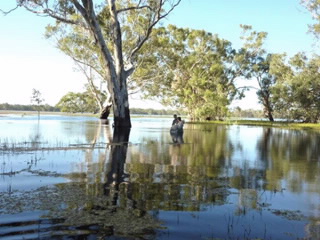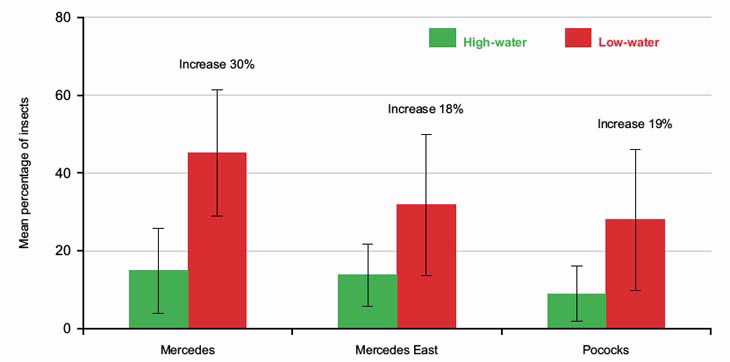 |
| Murray-Darling Basin. |
A study of Australia's wetlands by nuclear scientists has revealed native species are under the threat of extinction if water management practices in places like the Murray-Darling basin are not improved.
Introduction
Australia’s wetlands undergo frequent stresses from droughts and floods that impact life-sustaining wetland functions for a diverse range of aquatic, avian, and terrestrial biota.
During these periods of changes in water levels, the food webs of the wetland shift, increasing the competition between native and introduced species.
The impacts that occur can be measured using the isotopes of carbon and nitrogen - the fundamental building blocks of wetland animals and plants.
Our study adds to the understanding of how wetland health fluctuates as a result of natural and human-caused changes, and aids in knowing what actions are needed to sustain functioning wetlands.
Wetland ecology
Wetlands in the Murray-Darling basin are internationally recognised for their unique qualities in providing breeding and nursery grounds for numerous species, and providing food and water for aquatic, avian, and terrestrial biota as well as supporting human activities that depend on healthy functioning river-systems.
Over the past decade these wetlands became increasingly isolated, diminished in area, and subject to dry periods due to land-use practices, water diversion, drought and climate variability.
Due to heightened interest by river-basin management agencies regarding “managed environmental flows” and other measures to alter flow regimes, we need a better understanding of the impacts of such measures on wetland ecology.
Our primary objective is to improve the understanding of the changes to the health of wetlands resulting from fluctuations in flow regimes such as drought-induced low flows, flooding, and managed environmental flows.
Key tools for this study include an Isotopic Ratio Mass Spectrometry (IRMS) laboratory and a suite of isotopic modelling software for simulating food-web relationships.
ANSTO’s capabilities are combined with those of the Office of Environment and Heritage, Department of Premiers and Cabinet, NSW to provide input to the sound management of Australia’s riparian wetlands.
 |
| Postulated food-web connections among species in the wetland system |
Stable isotopes as tools for wetland ecology
Stable isotopes of carbon and nitrogen make up the fundamental building blocks of wetland animals and plants, and therefore the carbon isotope ratios 13C:12C (designated as δ13C) are used as a tracer of food ‘source’ [2] while nitrogen isotope ratios 15N:14N (designated as δ15N) are indicative of consumers’ trophic position in a food web [3].
By measuring the relative abundance of stable isotope ratios (δ13C and δ15N) in sediment, algae, invertebrates and fish, we determine food-web relationships that when mapped over a period of changing conditions reveal how the food web is impacted.
Samples were gathered from key ecological compartments, i.e. sediment organic matter, plants, macro-invertebrates, aquatic insects, and fish in three wetland water-bodies in the Lowbidgee floodplain wetland system within Yanga National Park, NSW, Australia.
We compared a wetter seasonal period following the release of a managed environmental flow with that from a later period of drier conditions and contracted water-pool levels and areas.
During this recession event, water volumes in the three water bodies reduced by 88-98%. Our study evaluated shifts of δ13C and δ15N data in the food web resulting from the reduced water-levels and in particular the potential impacts on native species.
Shift in the food web
The food web was altered during the change from high-water to low-water conditions in the Lowbidgee floodplain wetland, but in a different way than we expected. Although algae showed a relatively large depletion of -25‰ (the largest δ13C shift) we found that higher-order animals do not show the same δ13C shift.
Apparently, algae do not represent the dominant food-chain base. However, sediment organic matter shows a δ13C ratio shift of about 2-4‰ that consistently tracks that of insects, fish, and other organisms higher up the foodchain.
This has interesting implications as the makeup of the sediment organic matter is highly influenced by overland runoff which is in turn determined by the riparian biotic community and nearby land-use practices.
Native versus introduced species
During low-water conditions, heightened competition occurred for similar food items (insects) between native carp gudgeon (Hypseleotris spp), a small insectivorous fish, and an introduced European carp (C. carpio) a larger omnivore that preys opportunistically on insects.
The two species were well separated in their food-chain positions during high water levels, illustrated in Fig. 2 when comparing a plot of δ13C and δ15N values.
During low-water conditions they occupied almost the same food-web position suggesting the two species were competing for similar food items in food-scarce, constricted low-water pools.
The increased competition for insects was also indicated by a model analysis that considered the various food-sources available to European carp in the high-water and low-water conditions in three different wetland water-bodies. Fig. 3 shows modelling results of isotopic mixing that suggest the percentages of insects in the European carp diet increased by 18-30% in low-water conditions.
Consequently, European carp’s increased consumption has a direct effect on native carp gudgeon as insects are the primary diet source of carp gudgeon.
 |
| Figure 3: Isotopic (δ15N) diet mixing model outcomes for European carp in high-water and low-water conditions in three wetland water bodies. Whiskers represent 5th and 95th percentiles of probabilistic model outcomes. |
Management Implications
We observed shifts in food chain relationships during changing (decreasing) water levels which indicate lower trophic aquatic animals relied on sediment organic matter as the dominant base of their food chain instead of algae or macrophytic plants.
Because the sediment organic matter is highly influenced by overland runoff from a variety of river floodplain activities, the land uses such as farming occurring on nearby floodplains and catchments have the potential to impact the wetland food chain directly.
River management strategies consider the length of low-flow periods between controlled releases and the degree to which wetlands are allowed to dry out.
Our observation of native fish species in the Murray-Darling basin show heightened competition between native and exotic fish species during periods of low water flows. This finding indicates that extended low-water conditions could reduce populations of native fish species in the Murray-Darling basin wetlands.
Further study is needed to determine the likelihood of displacing native species at large scales [4], and the impacts to other species including floodplain predators and birds that rely on native fish populations.
Authors
Debashish Mazumder1, Mathew Johansen1, Suzanne Hollins1, Yoshi Kobayashi2, Jordan Iles2,and Neil Saintilan2
1ANSTO and 2Office of Environment and Heritage, Department of Premier and Cabinet, NSW
References
1. Kingsford, R. T. (2000). Ecological impacts of dams, water diversions and river management on floodplain wetlands in Australia. Austral Ecology, 25(2), 109-127.
2. Hecky, R. E., & Hesslein, H. R. (1995). Contributions of benthic algae to lake food webs as revealed by stable isotope analysis. Journal of the North American Benthological Society, 14(4), 631-653.
3. Zanden, V., Jake, M., & Rasmussen, J. B. (2001). Variation in δ15N and δ 13C trophic fractionation: Implications for aquatic food web studies. Limnology and Oceanography, 46(8), 2061-2066.
4. Bunn, S. E., & Arthington, A. H. (2002). Basic principles and ecological consequences of altered flow regimes for aquatic biodiversity. Environmental Management, 30(4), 492-507.
Published: 02/05/2012


